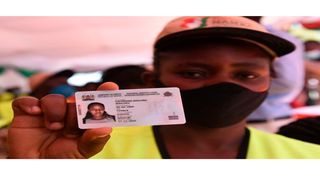
Catherine Wanjiku displays her Huduma Namba card after receiving it from the Kiambu County Commissioner's office on November 18, 2020.
| Evans Habil | Nation Media GroupNews
Premium
How defaulted mobile loans became Huduma Namba's Achilles heel
A montage of factors, including defaulted mobile loans and a change in the distribution policy by the government have left the issuance of Huduma Namba cards in limbo.
Lately, millions of Kenyans have been left dumbfounded after being told to travel hundreds of kilometres to collect their cards.
Previously, the recipients would be asked to choose where they would want their cards to be sent. Now, the cards are sent to one’s location as stated on their national identity card. That’s not all. The government, which started mass distribution of the cards in February this year, has been sending applicants messages on their mobile phones to go and collect them but the messages, some say, are unintelligible.
Those who spoke to the Nation said the card is not a crucial document and they would not waste their time or money to go and pick them.
Embakasi Senior Assistant County Commissioner Peter Yego lamented that it was worrying that people do not want to collect their cards.
He also admitted that the messages were not clear and that officials were talking with the headquarters so that the text messages that will be sent will be clearer.
“Yes, I can confirm that the messages that the government is sending do not indicate the exact location of the pick-up point and that is one of the reasons people are not coming to collect the cards,” said Mr Yego.
He added that despite Embakasi leading in card distribution, it has only managed to distribute only 9,000 of the 82,000 cards sent.
“We suspect that some of those who applied for the card might have moved to other locations due to the pandemic. We also suspect people are not coming because of the distance and they do not want to spend money on transport,” he said.
Mobile loans
He also predicts that some of those who applied for the card, being youths, might have changed their mobile phone numbers, which means they did not get the messages to collect the cards. This could be because they borrowed money using their mobile phones and discarded the SIM cards when they were unable to repay the loans.
His sentiments were echoed by Murang’a County Commissioner Mohammed Barre, who said the distribution of the cards among the youth has been a challenge as many have changed their phone numbers after failing to repay mobile loans.
Already, 5,000 cards have been issued to residents, out of 51,000 applicants, he said. He added that distribution will be a joint venture between the chiefs and the village elders to ensure success.
The major hurdle has forced the administrators to team up with the community and church leaders to help in the identification of the missing individuals.
In Nakuru, Deputy County Commissioner Mike Esimum is also pleading with residents of Nakuru West to collect their cards.
“Check with your local chiefs and see if your cards are there,” he said.
In Nairobi, Starehe Deputy County Commissioner Flora Mworoa also urged those who were yet to collect their cards to do so, saying only 43,000 of the 286,000 cards received in Nairobi had been collected.
Starehe Sub-county received 13,529 cards but only 3,231 have been collected.
Kiambu County Registrar of Persons John Njuguna said applicants should visit Ndumberi, Ting’ang’a, and Kiambu registration offices to collect their cards.
“We have been mandated to distribute these cards alongside other administrative offices in our sub-county where the residents will pick them from,” said Mr Njuguna.
He called on those who had received the notification message to collect their cards immediately, to clear the backlog.
“Some people may have lost their phones or stopped using the numbers they used to register. Some may have changed their SIM cards for one reason or another and this may have been posing a challenge to the collection, which has been slow,” he added.
Mass Distribution
Only a paltry 10 per cent of Kenyans have picked their Huduma Namba cards after the roll-out of mass distribution by the government.
Government spokesperson Cyrus Oguna last month said only 300,000 out of two million people have responded to the text messages sent to them and collected them since the rollout of mass distribution on February 2.
Speaking during a press briefing in Nairobi, Col (Rtd) Oguna urged those who had received the messages to provide the requested information, and then pick up the cards.
The spokesperson noted that most Kenyans delay in choosing the location where the card should be sent despite getting messages on their phones asking for that information.
“The options are actually in a link. You click the link and you will be given options. So you choose an area that is convenient to you,” he said.
He said Kenyans have three days to respond to messages calling them to collect their cards, after which the message link will expire.
“When the message disappears and your card is ready, we go back to records, find out where you registered and send the card to a bureau near where you registered,” he said.
In March, Col (Rtd) Oguna warned the public that fraudsters had been asking for money, claiming to be in a position to distribute the cards.
He added that Nairobians can now visit collection points on weekends between 8am and 4pm.
Huduma Namba is a system that seeks to register all Kenyans under a new database.
The registration process requires information from the user, including their biometric data.





